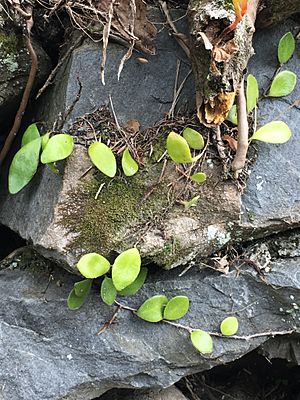Leather-leaf fern facts for kids
Pyrrosia eleagnifolia, also called the leather-leaf fern, is a special plant found only in New Zealand. The Māori people call it ota. This fern has thick, rounded leaves. It can grow on the ground or climb on trees as an epiphyte.
Quick facts for kids Leather-leaf fern |
|
|---|---|
 |
|
| Scientific classification | |
| Synonyms | |
|
About the Name
This fern was once mixed up with another fern. That fern is called Pyrrosia serpens. It grows in the Pacific Ocean area. The name eleagnifolia describes how the leaves look. It comes from two old words. Elaeagnus means olive, and folium means leaf. So, the name means "olive-leafed" fern.
What Does it Look Like?

The leather-leaf fern has thick, single leaves. These leaves are called fronds. They can be long and thin, up to 20 cm (8 inches) long. Or they can be short and wide, about 2 to 3 cm (1 inch) wide. The fronds grow from long stems. These stems creep along the ground. They are called rhizomes.
The fronds that do not make spores are usually shorter. They are also wider than the fronds that do make spores. All the fronds are thick and feel like leather. They are smooth and rounded at the ends. The top side is dark green. The underside has many light-brown hairs. These hairs are branched in an uneven way.
Where Does it Grow?
You can find P. eleagnifolia all over New Zealand. It grows from the Kermadec Islands in the north. It also grows down to Stewart Island and the Chatham Islands. This fern is very tough and can live in many places. It can handle dry weather. It grows on trees as an epiphyte. It can also grow on rocks. You can find it from the coast up to the mountains. It is not as common in the south of New Zealand. This is especially true in Central Otago.
Pests and Diseases
Some moth caterpillars like to eat this fern. They feed on its leaves. They also eat the sori, which are where the fern's spores are made. Some of these moths include Sarisa muriferata and Calicotis crucifera. Other moths are Philocryptica polypodii, Apoctena taipana, Eudonia zophochlaena, Scoparia illota, and Scoparia molifera.

